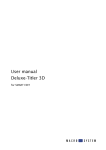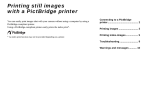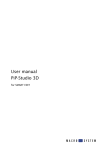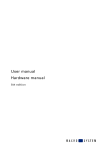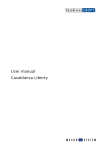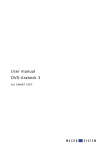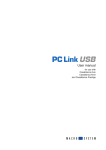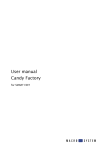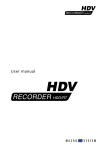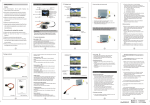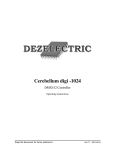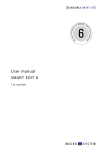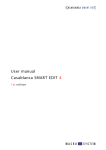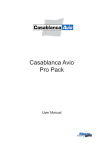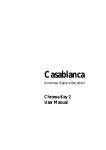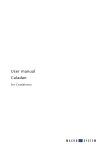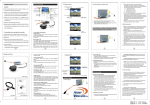Download User manual Pro-Pack
Transcript
User manual Pro-Pack 3rd edition Content Page 1. General information.......................................................................................... 3 2. Installation / Starting the program................................................................... 3 3. Functions............................................................................................................ 4 3.1 Project Settings screen ......................................................................... 4 3.2 Record screen........................................................................................ 4 3.3 Edit screen ............................................................................................. 5 3.4 Finish screen.......................................................................................... 7 3.5 Transitions screen ................................................................................. 7 3.6 I.P. Effects screen................................................................................... 8 3.7 Titling screen ......................................................................................... 10 3.8 Audio Record / Edit screen ................................................................... 11 3.9 Audio Mix screen .................................................................................. 12 3 1. General information Thank you for purchasing the Pro-Pack! We appreciate the trust you have placed in our company and our products and hope that this package will fulfil all of your expectations. With the Pro-Pack software, your system will become much more powerful and efficient (the individual features of this software package are explained in the Functions section of this manual). This manual will help you with the installation and the application of the Pro-Pack. We are available for further questions and suggestions about future improvements. Whenever you contact us, please have your customer number or the serial number of your device at hand so that we can help you more quickly. Address : MacroSystem Digital Video AG Postfach 020240 58290 Wetter Germany MacroSystem US 5485 Conestoga Court Boulder, Colorado USA 80301 Phone 0 +49 (0)2335/960-0 303-440-5311 (Germany) (North America) E-Mail [email protected] [email protected] (Germany) (North America) Fax 0 +49 (0)2335/960-100 303-440-5322 (Germany) (North America) Up-to-date information on MacroSystem products and our sales department can be found on the Internet. Please visit our Websites: http://www.macrosystem.de (Germany) http://www.macrosystem-enterprise.de http://www.macrosystem.us (North America) Phone Support If you have special technical questions, you can call our technical support hotline: (North America) Monday - Friday 9a.m. - 5p.m. (Mountain Standard Time) 303-801-1010 Outside of these times you can email or fax us. Messages received in this way are handled during business hours. E-Mail Support [email protected] (Germany) [email protected] (North America) [email protected] (N.A.) [email protected] (N .A.) Fax Support +49 (0)2335/960-110 303-801-1058 (Germany) (North America) 2. Installation / Starting the program Leave your system switched on and, in the System settings menu, press the Install product button to open the corresponding window. If you are installing from a SmartMedia card, insert it into the drive. When you insert the card, make sure the gold-colored contacts are facing downwards and the beveled corner is at the front left, i.e. pointing towards the device. If the Pro-Pack software is supplied on a CD/DVD and your system is equipped with a DVD drive and the DVD-Arabesk software, you should open the drive tray and insert the CD/DVD into the DVD burner. If you are installing from a CD/DVD, you might hear clearly audible sounds coming from the drive – this indicates that the system is reading the CD/DVD. 4 In a moment you will see the Pro-Pack software listed in the Install product window. Select it from the list and click on Activate / License. After a short time a numerical keypad appears. You can use it to enter the license code that you purchased from your dealer. A message will then inform you that the installation process has completed. You can now take out the SmartMedia card or CD/DVD. 3. Functions 3.1 Project Settings screen Notice that the items in the project settings have been reordered. After you have clicked on OK, the name of the project you selected will be displayed next to the Select button (e.g., P1). If you want to rename the project, click on the project’s current name (P1) and a keyboard will appear, enabling you to enter a different name for it. It’s important to remember that you can only edit the project that’s currently active. Exchanging video and audio data between different projects is possible using the Clipboard feature in the Edit screen. You always have access to archived titles and colors. For further information please read chapter 3.3 Edit screen and 3.8 Audio Redord/Edit screen. The Format button provides different settings. In addition to the normal 4:3 formats, the system also offers a 16:9 Anamorphic mode. The three standard options for selecting projects have been replaced by the Select button. Clicking on it opens the Select project box, where you can select from up to thirty different projects: The option means the 16:9 mode anamorphic and contains 576 picture lines. 16:9 is set when starting the project. This special mode works only if both camcorder and TV conform to the 16:9 standard. It might be necessary to manually switch the TV monitor to 16:9. If the TV is not switched, then SMART EDIT uses the standard display 4:3. 16:9 display is possible regardless of the format in which the video source has been recorded. 3.2 Record screen A new Mode button has also been added to the Record screen. It offers you three recording options: 5 changes. Scenes recorded prior to that may require a longer time period for the automatic split. The splitted scenes will appear in the scene bin. • Normal for standard recording. • Time enables you to determine the exact recording length (the recording automatically stops). The Insert, Range, Split and Trim toolbars now include a button with speaker icon; this is the Waveform button. When you click on it, a Waveform display appears. • Photo is for still images. Your system records material for approximately half a second, which is then automatically looped for the clip length that you’ve set with the Time controller. The setting Photo is appropriate for single flicker-free pictures. The Time slider is activated by the modes Time and Photo. The Time mode allows setting the duration for the still scene up to 100 minutes. In Photo mode you can set the duration of the still scene up to one minute. You can interrupt the recording any point (even if you’ve preset a recording time) by pressing the Stop button. 3.3 Edit screen If your system is equipped with the DV option, you’ll see the Auto button in the Split function. When capturing via FireWire from a cameraoriginal tape, you can capture the full tape and then click once on Auto and the system will split the scene instantly into smaller clips. The video scene that you have filmed most recently is split up very quickly according to shot This display represents sound over a period of time, whereas the height of the curve shows the different volume levels (the higher the curve, the greater the volume) and the width shows the period of time expired. A black, vertical position marker indicates your current frame position (this position marker is also displayed while you scroll through the scene or the audio file). If the Waveform is on, you’ll also be able to hear your scene’s audio while you’re scrolling through it. Depending upon the scrolling speed, you will hear it faster or slower than it was recorded (“scrubbing”). If you select the In, Out or Split Position buttons and if you do not move the trackball for half a second, the Waveform will automatically replay (a vertical bar shows the current position of the playback). When you’re trimming the beginning of a scene (In), the black position marker will be on the left of the display. When you’re trimming the end of a scene (Out), the black position marker will be 6 on the right of the graph. As you scroll through the scene you hear the corresponding audio. Depending on the scrolling speed you hear the audio faster or slower (often referred to as "scrub audio”). The wave form has two different display forms. When scrolling through the scene you see a detailed wave form or a segment of the wave form. As soon as you receive a preview of the last second the wave form for the entire playback time is shown. You can disable the Waveform simply by clicking on its button once more (it will turn gray). An additional function is splitting a scene in series through the Index button. Click (in the splitting menu) on the Play button so that you see the Index button. While the video is running with audio, each time you click on the Index button a split position is set. Afterward the split segments are positioned after the original scene in the scene bin. This function serves to roughly split up a scene before you begin with final editing. Enhancements also have been added to the Edit, Special menu. Click on the Special button and you’ll see that a bar separates the image-processing effects from the special effects. A new special effect you can select is the Clipboard function. On the right are four functions: Clipboard --> Project, Scene -> Clipboard, Remove scene and Scene from project --> Clipboard. If you click on Scene --> Clipboard, the scene you selected from the scene bin will be added to the Clipboard (if there’s no scene in the scene bin, a No scene currently available! message will appear). Before you load a scene from the Clipboard you’ll need to choose a place in the scene bin for it to go. (To do this, click on any scene in the scene bin, and the Clipboard scene will be placed after it.) When you click on Special, then on Clipboard and then select Clipboard --> Project, the Load Scene from Clipboard dialog box opens. Here you can select the scene you want, click on OK and leave the Special menu by pressing OK. You will then see that the scene that has been added to the scene bin (it may have a new number if the scene or the scene name is already stored in the scene bin). If you click on Remove scene in the Clipboard, the Remove scene from clipboard box will open and you can mark the scene you want to delete from the Clipboard. Click on OK to delete the scene. Tip: If you click on Remove scene, you’ll notice that the OK button is grayed out and disabled. This is a safety feature that prevents the accidental deletion of a scene. However, if you want to delete a scene, just click on the scene you want to delete (even if it’s already grayed out) and then click on the now-active OK button. The function Scene from project --> Clipboard is used to choose scenes in other projects without entering the project settings. Clicking on the button Scene from project --> Clipboard opens the screen Select project, in which you can choose one of your Projects, from which you want to export a scene. After marking a project and having clicked on "Ok", the scene bin of the activated project opens from which you can choose the desired scene. After confirming with Ok the scene is transported in the clipboard. Now you can click on Clipboard --> Project, so that a window appears in which you can mark 7 the scene you just exported. After confirming with Ok, the scene will be imported into the scene bin of your current project. The clipboard serves principally to store video scenes temporarily in order to use them in other projects. The clipboard can be accessed from any project. Here you can also use the wave form to help you in deciding on the segment. 3.5 Transitions screen In this screen you’ll notice a Full Size preview option. Note: The scenes contained in the clipboard are deleted when you turn off your machine. Of course, it is also possible to copy DV material into an HDV project with the aid of the Clipboard. Note: If you switch projects and use new project settings, then the scenes already contained in the clipboard are marked with an asterisk and may not be usable. If you select one of these scenes in order to insert it into the scene bin, the These scene properties do not conform to project settings! message appears. 3.4 Finish screen After you have added a transition effect and perhaps defined its duration, you can click on the Full Size button and bring up a further preview menu. In this menu you will see the new Range button. Clicking on the Choose Range button brings up a menu in which you can specify a segment of the storyboard (using the IN and OUT buttons and the arrow buttons) to be recorded out. There you see the middle frame of the transition effect. The video image is superimposed by an operating panel in which you can see the effect options (if available) on the right side. On the left side you see the button Frame. You 8 can use this button to specify the point in time of the transition effect you want to see. In this way you can observe the applied effect at any point in time of the scene. You can scroll slowly through this part of the scene and view it at the same time. The button Display positioned below offers you the choice between Original (representation of the new scene you have just chosen) and Compare. The last option divides the screen into two parts. Your new scene is displayed in the right half of the screen. In the left half of the screen a scene is displayed that you can freely choose from the scene bin with the button Choose scene positioned below. This comparison function lets you, for example, adjust the color to correspond to an existing scene. You can also change the effect options to directly compare different colors or directions. Here you’ll also get a real-time preview, too. The settings made in this menu are confirmed with OK and you are returned to the Edit menu. With Cancel you leave the Full Size menu without saving any changes. The arrow button serves to move the menu bar to the upper screen edge, whilst the button above allows you to minimize the user panel. Note: Real-time effects can not be monitored in single-frame preview. name by clicking and using the keyboard that appears. You also see the three options Effect, Effect + scenes, and Range. If you only want to convert the effect with the previously set range into a new scene, then click on Effect and then on OK. This causes the effect to be converted into a scene and to be put into the scene bin of the Edit menu. You can also let the length of the new scene extend beyond the range of the two previous scenes (with inserted effect). In this case click on Effect + scenes and then on OK. This way, a new scene is generated and then added to the scene bin. Alternatively, you can create the scene from the entire length of or from a portion of the storyboard. Click on Range and confirm with OK. Use the IN and OUT points (in the now familiar Range menu) to select the range of the new scene. The wave form can help you to do this. It can be displayed/hidden with the loudspeaker symbol. Then click on OK in the Range menu and the scene is created and stored in the Edit menu. Of course, you can also create a separate scene from a portion of the storyboard in which there is no effect. Simply select a point in the storyboard and click on Scene. In the window that is displayed only the function Range is enabled. Specify a range and click on OK. Then you can view the new scene in the Edit menu. You’ll also notice the presence of a Scene button in this screen. Now you can make use of the multi-layer technique. If you want to overlap several transition effects, you at first add one effect between two scenes and create it. Then you create a single scene from the two scenes and the inserted effect. To do this you click on the Scene button so that a window appears in which you can select the range for the new scene. The name of the used transition effect appears next to Name and is given as default name for the new scene. If desired, you can enter another 3.6 I.P. Effects screen As was the case in the Transitions screen, the I.P. Effects screen now features a Full Size preview button. 9 half. In this way you can easily compare the original with the applied effect. The option Compare divides the screen into two parts. To the right you see your new scene (with effect) and to the left a scene that you can freely choose from the scene bin using the button Choose scene positioned below. This lets you, for example, exactly adjust the color to correspond to another scene. After you have inserted an Image Processing effect and perhaps specified its range, you can click on Full Size to bring up an additional menu. Above the function Display you see the Frame slider with which you can set the point in time of the long-term effect that you want to view. In this way you can view the inserted effect at any point in time of the scene. The button does not have to be confirmed, so that you can scroll slowly through the scene and view the effect at the same time. Of course, you can change the effect options as you wish and thus have the possibility of directly comparing various colors and directions. The effect options set in this menu are accepted with OK and you are returned to the Edit menu. With Cancel you exit the Full Size menu without changes. The arrow button serves to move the Singleimage menu to the upper screen edge, whilst the button above allows you to minimize the user panel. Note: Real-time effects can not be monitored in single-frame preview. In the background you see the middle frame of the entire segment for the inserted Image Processing effect (if the effect is applied on the entire scene, then you will see the middle frame of the video scene). An operating panel with effect options (to the right, if there are any for the selected effect), overlays the video. To the left you see the button Display with four available possibilities. With Original you can view your original scene. With Effect you can observe your scene with the applied effect. Orig. + Effect displays the original scene in the left screen half and the applied effect in the right You’ll also notice the presence of a Scene button in this screen. If you would like to overlay several long-term effects, you at first insert an effect into a scene and create it. Then you convert the scene with the inserted effect into a separate scene. To do this click on the button Scene. A window appears in which you can select the range for the new scene. The name of the effect applied appears under Name as default name for the new scene. You can change this name by clicking on it and calling up the keyboard. You also have the three options Effect, Effect + 10 Scene, and Range. In order to make a new scene just from the effect with the previously set range, click on Effect and then on OK. The effect is turned into a scene and put into the scene bin of the Edit menu. You can also adjust the length of the new scene to the range of the previous scene (with inserted effect). In this case click on Effect + Scene and then on OK. The new scene is created and appears in the scene bin. Alternatively, you can create the new scene from the entire length or a segment of the storyboard. Click on Range, confirm with OK, and use the IN and OUT points in the familiar Range menu to select the range containing the new scene. The wave form can be of help and can be toggled on/off with the loudspeaker symbol. You can operate the titling menu in much the same way. Of course, you can generate a separate scene from an effect-less range of the storyboard from within this menu too. This works in the same fashion as explained for the Transition Effects. 3.7 Titling screen The Pro-Pack also enhances your Titling screen’s capabilities. Next to the preceding scene functions, you can see a new buttons called Line. Enter the text editor and press the Text button. The menu that appears next contains the new Line button. Clicking on this button opens a window in which the functions Character width, Character space, Alignment, Line space and Delete active line are listed. You can see that the settings of the buttons with percent values lie between 50% and 200%, whereby 100% corresponds to the default setting. In the Enter/edit text screen, click anywhere in the line of text to be edited. Then select the button Line and under Character width enter the desired percent. Click on OK to observe the result. The letters have become wider (> 100%) or narrower (< 100%), depending on the percent given, and the entire line has become either longer or shorter. The individual words in a line cannot be formatted separately. The settings apply only to the entire line. The function Character space increases or decreases the space between the letters. In the Enter/ edit text screen, click anywhere in the line of text to be edited and select the button Line. Use the Character space slider to enter the desired percent of the distance. The line is stretched (> 100%) or narrowed (< 100%), depending on the percent value given. The individual words in a line cannot be formatted separately. The settings apply only to the entire line. Under the selection button Alignment you can specify whether the line should be formatted left, centered or right. With the function Line space you can specify the 11 distance between the selected line and the line below it. In the Enter/edit text screen, click on the line that lies above the line to be changed. Now select Line and under Line space change the default value (=100%) to another value. If your percent number is smaller, then the line below moves closer to the selected line. If your percent number is larger, then the line slides farther away toward the bottom from the selected line. The lines below the moved line are moved along with it, but keep their respective distances. You can also make several settings together in the Line window before clicking on OK. Note that the settings always apply to the line selected beforehand! The percent values you have set are retained. You can view the settings and changes for the line you have selected by activating the Line window. Here you can also modify the percent values. (If you have made changes but still see the default values of 100% in the Line screen, then you have selected the wrong line before clicking on Line.) Clicking on Delete active line causes the line containing the position marker to be deleted. The window disappears. 3.8 Audio Record/Edit screen When you enter the Audio record/edit screen, select an audio file from the sample list and then click on either Split or Trim, you’ll now be able to see the same Waveform display that was described in the video editing section. In both cases, the audio envelope works the same way as in the video relevant menus – however, it can not be switched off as it doesn’t cover any important interface elements. The wave form graphically displays the volume over time. The height of the curve represents loudness (the higher, the louder) and the width is a measure of time. You see a vertical, black position marker indicating your current picture position. This position marker is also shown when you scroll through the scene or the audio segment. The Audio Wave Form is automatically played when one of the buttons In, Out or Split Position is clicked and the trackball is held motionless for approximately 0.5 seconds. A movable, vertical white-hatch bar indicates the actual playback position. When trimming the beginning of a sample (In) the black position marker can be seen to the left on the curve. When trimming the end of a sample (Out), it can be seen to the right. 12 Depending on the scrolling speed you hear the audio faster or slower (often referred to as "scrub audio“). The wave form has two different display forms. When scrolling through the scene you see a detailed wave form or a segment of the wave form. As soon as you receive a preview of the last second the wave form for the entire playback time is shown. A new Clipboard function has also been added to Audio record/edit screen. If you click on Special and select Clipboard, you’ll see the four buttons (Clipboard --> Project, Sample --> Clipboard, Remove Sample and Sample from project --> Clipboard) that have the same functions as those in the Video menu. Tips: If you click on Remove Sample, you’ll notice that the OK button is grayed out and disabled. This is a safety feature that prevents the accidental deletion of a file. However, if you want to delete an audio file, just click on the sample you want to delete (even if it’s already grayed out) and then click on the now-active OK button. 3.9 Audio Mix screen The Pro-Pack enables you to use up to six audio tracks in your Audio Mix screen. The track at the top is reserved for the original source audio (camera icon) of the video, whereas the commentary track (microphone icon), the two tracks for the background music (musical note icon) and the two effects tracks (FX) are available for you to add clips to. Naturally, you can use these five tracks as you want to – the names and the symbols at the right side are only suggestions. The original source audio track, the commentary track and the effect tracks are “locked” to the scene(s) above them. If you make changes to the either of the scenes positioned before and after the audio clips on these tracks, the sound will move with the scene it was placed under. If changes are made to the scenes that overlap with the audio file, the audio will be deleted (after a warning message). Audio files placed in the music tracks are not connected to one scene, but maintain their position according to the starting point of the storyboard. If you make changes to the scenes positioned before and after the audio clips on these tracks, the audio will stay put while the storyboard scenes shift. Due to this varying behaviour, audio tracks that are `stuck´ to the video footage are particularly useful for commentary tracks or sound effect, whereas a music piece is probably more suitable as a background track. 13 Taking differences between the tracks into consideration, you can of course use them for purposes other than intended. Several other buttons in this screen have changed, due to the new number of sound tracks: The audio file list is now displayed in a separate dialog box when you click on Insert. Scroll through the list to select the sample you want, click OK and the sample will be placed at the beginning of the Workbox scene in the track that you designated. Note that if another sample is already at the beginning of the scene, the system will automatically insert the new sample immediately after the existing one. After it’s been placed, you can always move it with the Range button, if necessary. The title and length of the active audio file will be displayed at the bottom left in the menu. Another new function that has been added is the ability to fade an audio file’s volume in or out. Select a sample and click on the Fade button to call up a dialog in which you can adjust fade-in and fade-out of the currently active audio sample. The audio volume is consequently reduced or increased for the selected duration (which of course cannot exceed the length of the audio sample), reaching the selected baseline volume at the end of fading. Should you therefore wish to fade a commentary in softly, you can for example select a fade-in time of 1 second (1 s), and thereby prevent the sound from being clipped. Should you wish to fade out an audio sample, the volume is gently reduced towards the end of the sample and is completely silent at the end of fading. The fade-in and fade-out times act upon all selected changes, i.e. including any changes to volume of the adjacent tracks. For example, as the commentary volume is being increased, the background music is gently reduced to the selected value. The volume characteristic is displayed clearly in the audio samples. If you then trim a sample or move it, the fade in and fade out times remain. Use the Volume button to adjust the volume of the active video scene. You can reduce the volume of the scene (negative dB value), mute it (slider fully to the left), or increase the volume (positive values up to 30 dB). Use this control for example to prevent a soft sound from being drowned by another sound which is too loud (e.g. piece of music on the background track). A change in volume is shown in the light-blue bar which forms the background to the audio samples. If the volume is reduced, the bar at the lower edge of the audio sample is also displaced. The longer the audio sample, the more clearly of course the characteristic is displayed. The Correction button modifies the volume of an audio sample for the complete duration of another audio sample. The change is shown by the blue bar in the audio sample. Once you have selected an audio sample (e.g. music) in one of its sound tracks (e.g. music sound track), you can then click on the Correction button. A list is displayed containing all six sound tracks. From this list, select the sound track (e.g. original sound track) in which you wish to modify the volume of an audio sample (e.g. vocals). Then slide the control located on the right of it to the left or right (to reduce or increase the volume respectively). This changes the sound in the track which you previously selected (under Correction) for the complete duration of the audio sample activated in another track. By way of explanation, consider the following example. You have assigned audio to three tracks. The first contains the original sound, which extends throughout the storyboard. The third track contains a piece of music which begins whilst the original sound is running and which ends during a further original sound. 14 Select this piece of music. Then click on the Correction button to call up a list of all sound tracks. From this list, select the original sound track and reduce the volume by means of the button adjacent to Correction until it is muted. You now have no original sound for the complete duration of the piece of music. You can now hear the music at this point of the video without being disturbed by the original sound. The second track contains a commentary which begins in the middle of the piece of music and does not end until some time after the music has ended. Select the commentary. You can then reduce the volume of the music for the complete duration of the commentary by clicking on Correction, selecting the music track, and reducing the volume by means of the right-hand control. The original sound, which was muted for the duration of the piece of music, must now also be switched off for the remainder of the commentary. For this purpose, create a new piece of music: silence. Create a generous length. Insert it after the piece of music, and trim it using the Range button up to the point in the video at which the commentary ends. If you cannot find the point in the video easily from the material, calculate the correct position if necessary. The volume control for the track in which the audio sample is activated is of course not selectable under Correction, as changes affecting the volume must be made by means of the Volume button. You’ll also notice the presence of a Sample button in this screen, if you have installed Smart Edit 6. Click onto this button. A window similar to the Scene video effect menu (chapter 3.5 and 3.6) will appear. At first, you can see the name of the sample, which can be changed if needed. The default name is the name of the sample. Next, you can decide if you want to create a sample that runs across the length and position of the selected sample, combining all audio tracks in that position. To do this, click onto Sample and then Ok. The sample will then be added to the Audio Record /Edit screen. Another possibility is the Sample + Scenes function. Here, you can determine that the new sample starts at the beginning of the first scene – and ends at the end of the last scene it is positioned under. Alternatively, you can select any time range for creating the new sample. A sample is created, containing all sound from all soundtracks. Click onto Range, confirm with Ok and select the IN and OUT points from the already familiar Range menu. The Envelope (chapter 3.2 of the Smart Edit manual) helps you to do this. You can de/activate it using the speaker symbol. Click onto Ok in the Range menu. This creates the sample and adds it just after the currently activated/marked sample in the Record/Edit menu. 15 301-12/06
















